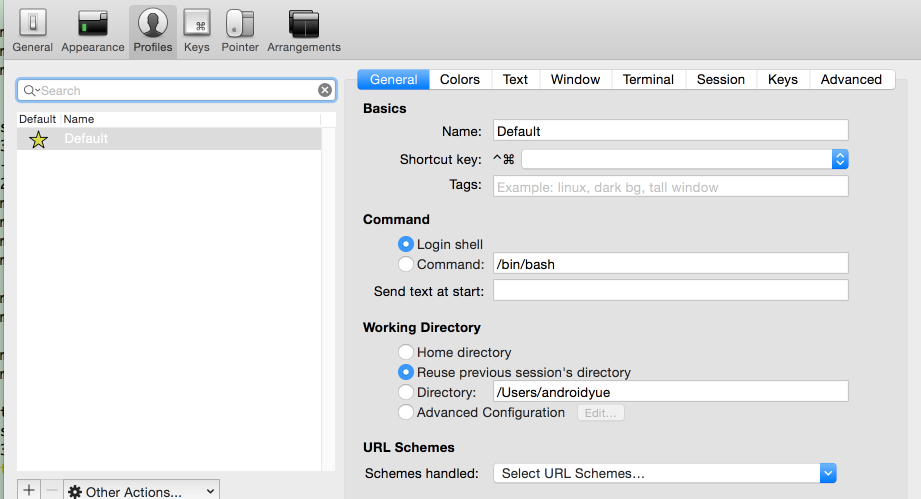

- #LINUX ITERM PROFILES HOW TO#
- #LINUX ITERM PROFILES MAC OS#
- #LINUX ITERM PROFILES UPGRADE#
- #LINUX ITERM PROFILES MAC#
- #LINUX ITERM PROFILES WINDOWS#
For one thing, it gives you access to a huge number of command line utilities, simplifying many everyday tasks.
#LINUX ITERM PROFILES MAC#
Also, running an outdated bash version probably expose you to some major vulnerabilities.īash is the default login shell on Linux and Mac OS, and adding it to your skillset will open up a whole new world of possibilities.
#LINUX ITERM PROFILES MAC OS#
Unfortunately the Mac OS operating systems doesn’t provide the latest version which may prevent you to take advantage of the latest features that came with Bash 4 and 5.
#LINUX ITERM PROFILES UPGRADE#
Upgrade Bash on Mac with Homebrew Reload and Verify Change The Default Bash on Mac GNU Bash is a powerful shell. If not, then you can always type fish in bash. If you wish to make fish your default shell, add add /usr/local/bin/fish at the very top of /etc/shells, and execute chsh -s /usr/local/bin/fish. You can see the prompt change, as well as a timestamp show up to the right of the window.


It offers neat improvements, like command spellchecks and suggested corrections. zsh: The Z shell is a modern take on the bash family of shells. While bash is the default login and interactive shell, dash is used to run system processes because it’s much lighter than bash. bash reads ~/.bash_profile if it is started by login (or with a -l parameter), bash does not care if it is started by iTerm or Terminal.ĭash: The Debian Alquist Shell is the default shell script in Ubuntu. This program starts a shell (listed in /etc/shells) by default this is /bin/bash. ITerm and Terminal are applications that start up a defined program - by default it is /usr/bin/login. profile then add it there, otherwise add it to. You need to add the following command to ~/.bash_profile or ~/.profile. iterm2 change default shell to bashĬurl -L \ -o ~/.iterm2_shell_integration.bash Next, you need to load the script at login time. $ echo $0 /bin/bash $ exec /bin/sh $ echo $0 /bin/sh Note: The above change is temporary. Use exec command to change your shell temporarily as shown below. You must log out and log back in to see this change. Your default login shell is /bin/bash now. It will prompt you to enter your password. The detailed command is chsh -s /bin/bash. bin/sh /bin/bash /bin/ksh /bin/zsh /bin/dash Yes you can use chsh or usermod to do the same things, please remember these are just structured text files, and TIMTOWTDI. Here's my /etc/shells if you're interested. bin/bash and /bin/zsh are both valid shells, see /etc/shells for a list of valid shells on your systems. Linux allows you to change the default shell using the chsh command.
#LINUX ITERM PROFILES HOW TO#
How to change the default shell in Linux permanently? Suppose you liked the Fish shell a lot and you want to use it as your default shell so that every time you open the terminal or ssh into the system, you are using it instead of the default bash shell. Also, macOS already have zsh even before this change. And because of the reasons quoted before, zsh is a great option. Zsh has a compatibility with Bash, which turns easy to make the transition. In a networked environment, a system administrator can specify the default shell. Under “Shells open with,” select “Command (complete path),” then enter the path to the shell you want to use. In the Terminal app on your Mac, choose Terminal > Preferences, then click General.
#LINUX ITERM PROFILES WINDOWS#
Then result should be /bin/bash.Īnswer from the Stack Overflow (switching from zsh to bash): You can just use exec to replace your current shell with a new shell: Switch to bash: exec bash Switch to zsh: exec zsh This won't affect new terminal windows or anything, but it's convenient. chsh -s /bin/bash Verify it again using echo $SHELL. To change it back to bash, issue the following command on terminal. echo $SHELL If the result is /bin/zsh, your task is completed. To check whether it's changed successfully to ssh, issue the following command. Then you need to enter your Mac password. Apple has been using the Bash shell since OS X Jaguar but hasn’t updated Bash since version 3.2 was released in 2007. They haven’t said specifically why the change is occurring, but we can make some educated guesses. Apple is changing from the Bash shell to the Zsh (Z Shell).


 0 kommentar(er)
0 kommentar(er)
